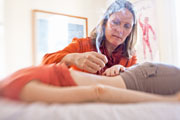The following writeup appeared in Fall 2011 edition of the Voice — the alumni magazine of my alma mater, Carleton College — as part of an article exploring the five senses:
Touch
Sometimes, fingertips are more useful medical tools than X-ray or MRI machines.
When Marilyn Yohe ’88 ushers somebody into her treatment room, one of her first tasks is to place three fingers on her patient’s wrist to feel for a pulse. Yohe, a licensed acupuncturist at Cambridge Health Associates in Cambridge, Massachusetts, will note the rate of the beat, just like a doctor or nurse, but she is also feeling for more than two dozen additional pulse qualities. “I’ll check for how deep the pulse is, how strong it is, and how wide it feels under my fingers,” she explains. “Sometimes the pulse feels slippery, like water pulsing through a garden hose, or choppy, like a wiper sputtering across a dry windshield.”
 Yohe, who graduated from the New England School of Acupuncture in 2004, has developed a finely tuned sense of touch that can distinguish among these subtle differences. The characteristics in the pulse alone can tell Yohe a great deal about a patient: A hard and wiry pulse that feels like a guitar string may indicate stress and tension, while a slippery pulse may suggest sinus congestion or even pregnancy. She acknowledges that practitioners of Western medicine might be skeptical about these diagnoses. After all, it’s difficult to measure something that is described in ancient texts as feeling like “a sick silkworm eating a mulberry leaf.” But, she points out, noting pulse characteristics is a technique that’s survived for thousands of years.
Yohe, who graduated from the New England School of Acupuncture in 2004, has developed a finely tuned sense of touch that can distinguish among these subtle differences. The characteristics in the pulse alone can tell Yohe a great deal about a patient: A hard and wiry pulse that feels like a guitar string may indicate stress and tension, while a slippery pulse may suggest sinus congestion or even pregnancy. She acknowledges that practitioners of Western medicine might be skeptical about these diagnoses. After all, it’s difficult to measure something that is described in ancient texts as feeling like “a sick silkworm eating a mulberry leaf.” But, she points out, noting pulse characteristics is a technique that’s survived for thousands of years.
Feeling the pulse is just one of the many diagnostic tools that Yohe uses to understand what is going on inside a person’s body, but it is one of the most important. The pulse is almost all that longtime practitioners need to start telling you what’s wrong, she says: “It’s a skill and an art that develops over time.”
While much of her work is done with needles, touch is a critical component of her practice. People may be uncomfortable being touched in a traditional doctor’s office, but they’re often more open to it with an acupuncturist. “Of course, you always ask first, but in general, people like to be touched,” she says. “When someone comes in complaining about pain in a certain place, the first and best thing to do is to put your hand where that pain is, because it’s soothing and it shows that you’re paying attention.”
In addition to creating that sense of connection, hands can serve as a navigator to the interior of the body. “Through touch, you can locate certain structures in the body and note where things might feel tight or soft, knotted or swollen,” Yohe says.
Doctors often seek solutions in environments that are technically advanced but sterile and formal, whereas Yohe’s personal approach can be effective in a way that not even the most advanced machines can manage. “When you’re in pain, you can feel alone with that pain,” she says. “When someone else has her hand on your body, that by itself can be reassuring and relaxing. You can just let your body be someone else’s problem for a little while.”
Erin Peterson, a Minneapolis freelance writer, is a frequent contributor to the Voice.
